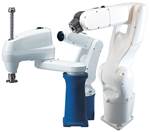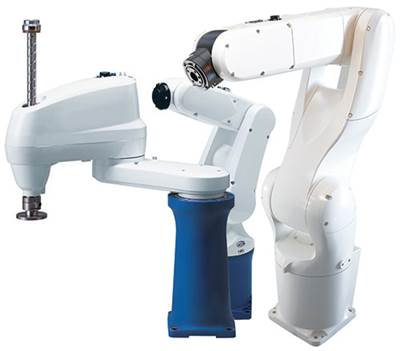Developments in the Man-Machine Connection
Like people, today’s collaborative robots understand what happens around them and behave accordingly.
Despite the frequency with which this topic has been discussed lately, the cooperation between man and machine is not a recent concept. Machine manufacturers for the production sector—and, above all, robot manufacturers—have always tried to figure out how to ensure easy interaction between factory operators and technological equipment, and how to make that relationship simple, quick and spontaneous. To understand how much effort was made to reach this goal, it is necessary to think about the study of robot interfaces.
The will to follow this path and the opportunities offered by modern technologies allow robot manufacturers to pursue their mission to combine production results with safety in the workplace, and to further develop man-machine relationships. In fact, we can now increase the intensity of this relationship, which means the percentage of true interaction between people and technological equipment, so as to achieve better results and actual, real-time cooperation.
Robots, together with the latest technological innovations related to them, are undoubtedly crucial elements in this change, as they can now act as true partners that work side by side with factory operators in tasks that either require limited strength and a lot of precision or the handling of heavy weights without losing accuracy and reliability. The combined use of different technologies is the element that makes this intense relationship possible.
Today, we are able to combine vision systems with force sensors, torque sensors, sensory abilities and scanning abilities that allow the operators to move safely within the work area they share with the robot while controlling its action either directly by means of manual guidance or the possibility to change its trajectory by touching it, or indirectly, thanks to the interaction with the sensors applied on the robot and in the entire work area.
As a result, by leveraging the relationship between humans as a model, we can provide a proper simulation of the human-machine relationship. Like people, today’s collaborative robots understand what happens around them and behave accordingly.
The advantages offered by this cooperation are remarkable. First, these robots can be used in the production sectors of heavy industry, as they can be applied to operations such as handling, machine tending and the assembly of heavy parts, to mention only a few. Another example is offered by the various manipulation applications that take place during the final assembly of a car, such as the positioning of the dashboard or the seats. Every operation, even those carried out by high payload robots, takes place without protective barriers, and this results in considerable savings in terms of costs and factory layout. In addition, the robot’s ability to interact in real time with the surrounding environment implies that production downtimes are almost reduced to zero, with remarkable advantages in terms of results, efficiency and productivity. Likewise, the scalability and flexibility resulting from these solutions should not be underestimated. The integration of different types of sensors allows custom configuration by gradually regulating the complexity of the machine and the accuracy of its control system. We are therefore heading toward the mass customization of robotics, which will be 100-percent collaborative and safe.
The tendency to intensify the relationship between man and machine is also clear in other fields of robotics. First, according to the latest international specifications for safety in human-robot cooperation, it is not only the body of the robot that is required to be safe. The entire cell must be “guaranteed” by extending the safety measures to, for example, the gripper. This specification, imposed by international procedures, further intensifies the relationship and “contact” between man and machine, making them reliable and totally safe.
Future developments—related to exoskeletons, for example—are moving precisely in this direction. In the near future, we can certainly expect the development of the first solutions in this field, and new contributions in robotic technology to human work. The objective is to make it lighter, more challenging and rewarding, as well as less repetitive, boring and burdensome.
The bond between man and machine is thus strengthened, creating a fair balance in the use of technology to support human work that results in an intense, safe and profitable relationship.
Related Content
Inside the Premium Machine Shop Making Fasteners
AMPG can’t help but take risks — its management doesn’t know how to run machines. But these risks have enabled it to become a runaway success in its market.
Read MoreAutomation in the Alps: Studer AG Unveils New Grinding Concepts
Studer AG, member company of United Grinding, held its annual press conference at its Swiss Alps location earlier this month to announce its new automatic loaders to accompany its existing grinding machines as well as other offerings and automation features.
Read MorePursuit of Parts Collector Spearheads New Enterprise
While searching for a small parts accumulator for Swiss-type lathes, this machine shop CEO not only found what he was looking for but also discovered how to become a distributor for the unique product.
Read MoreChuck Jaws Achieve 77% Weight Reduction Through 3D Printing
Alpha Precision Group (APG) has developed an innovative workholding design for faster spindle speeds through sinter-based additive manufacturing.
Read MoreRead Next
10 Considerations for Choosing a Robot
Knowing what to look for is essential when comparing and evaluating robots from different manufacturers.
Read More5 Aspects of PMTS I Appreciate
The three-day edition of the 2025 Precision Machining Technology Show kicks off at the start of April. I’ll be there, and here are some reasons why.
Read MoreA Tooling Workshop Worth a Visit
Marubeni Citizen-Cincom’s tooling and accessory workshop offers a chance to learn more about ancillary devices that can boost machining efficiency and capability.
Read More







.jpg;maxWidth=300;quality=90)













